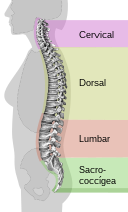Your spine is the root & center of your body. Are you really using it?
 One of the things you'll hear every GYROTONIC® and GYROKINESIS® instructor speak about is that GYROTONIC® and GYROKINESIS® training moves all your joints through all their ranges of motion. This is especially important for the spine. In our modern world of long commutes and sitting at computers, we rarely use all 6 of our spinal ranges of motion. And the "use it or lose it" axiom definitely fits when talking about the spine:
One of the things you'll hear every GYROTONIC® and GYROKINESIS® instructor speak about is that GYROTONIC® and GYROKINESIS® training moves all your joints through all their ranges of motion. This is especially important for the spine. In our modern world of long commutes and sitting at computers, we rarely use all 6 of our spinal ranges of motion. And the "use it or lose it" axiom definitely fits when talking about the spine:
According to Johns Hopkins Dr. Simeon Margolis, “back pain sends more people to the doctor than any complaint except upper respiratory symptoms.”
So in order to maintain the highest levels of back health, and thereby the lowest levels of low back pain, you want to move your spine in all the ways it is naturally meant to move. What are those ranges of motion?
It might seem like there are infinite spinal ranges of motion, but there are only 6 primary motions.
Extension - opening the spine to the front, what we in Gyrotonic call an Arch
Flexion - opening the spine to the rear, what we call a Curl
Rotation - turning your spine around a central axis
Lateral Flexion - a side bend
Lateral Glide - the spinal vertebrae glide on top of each other in a side to side motion, while staying more or less parallel to each other
Circumduction - a circular motion of the spine. There are two types of circumduction:
- internal circumduction - the ends of the spine (the head and the hips, stay in place and the middle of the spine makes a circular motion around the vertical centerline of the body
- external circumduction - the hips remain in place and the spine makes an outward circle with the head leading the motion
All other motions your spine may do are a combination of these six primary spinal motions.
There is a way of moving from one range of motion to the next called undulation. Undulation can be found throughout Gyrotonic training. In undulation, you move from one spinal range of motion to it's opposing motion, for example from Arch to Curl, one vertebrae at a time. So the transition from one range of motion will begin at one end of the spine and will draw each sequential vertebrae into the motion, one at a time. It is a very graceful and fluid way of moving your spine and is beautifully demonstrated by a Sidewinder snake on land or any water snake swimming.
So there are your six spinal ranges of motion, plus undulation.
If you live on Maui and want to learn to move your spine with purpose, get in touch!
GYROTONIC and GYROKINESIS are registered trademarks of Gyrotonic Sales Corp and are used with their permission.

